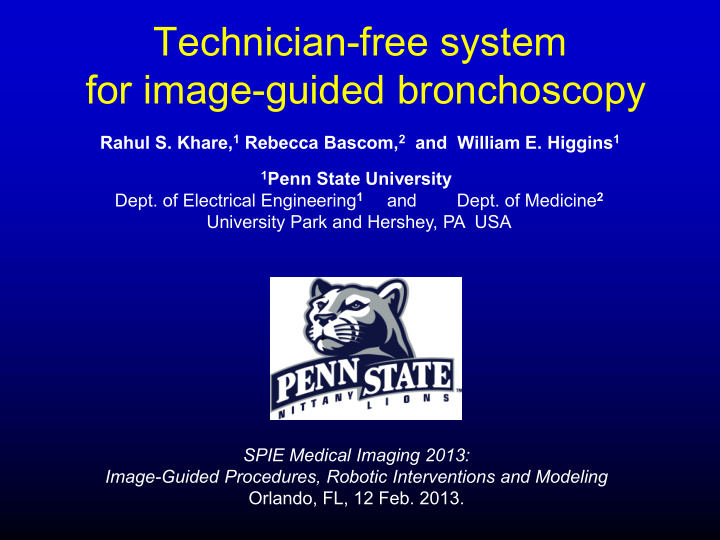



Technician-free system for image-guided bronchoscopy Rahul S. Khare, 1 Rebecca Bascom, 2 and William E. Higgins 1 1 Penn State University Dept. of Electrical Engineering 1 and Dept. of Medicine 2 University Park and Hershey, PA USA SPIE Medical Imaging 2013: Image-Guided Procedures, Robotic Interventions and Modeling Orlando, FL, 12 Feb. 2013.
Lung Cancer Assessment 1. 3D MDCT image-based planning
Lung Cancer Assessment 1. 3D MDCT image-based planning 2. Follow-on diagnostic bronchoscopy Drawing by Terese Winslow, “Bronchoscopy,” NCI Visuals Online , National Cancer Institute
Bronchoscopy Guidance Systems “Manual” lung cancer assessment is HARD!! EM-, image-, and sensor-based bronchoscopy guidance systems mitigate difficulty, but …. • Need an attending technician • Need extra hardware • Unable to detect faulty maneuvers • Lengthy re-synchronization after adverse events References: Helferty2007, Higgins2008, Solomon2000, Gildea2006, Schwartz2006, Wegner2007, Cornish2012, Luo2011
Our Approach to Image-Guided Bronchoscopy 1. Pre-procedure planning – Khare SPIE MI 2011 • Compute natural bronchoscope navigation maneuvers 2. Bronchoscopy navigation – Khare SPIE MI 2010 & 2012 • Technician-free guidance • Enable bronchoscope position verification via global registration
Precompute Guidance Paths using standard bronchoscope maneuvers 1. Rotate bronchoscope to left or right 2. Flex bronchoscope tip 3. Advance / withdraw bronchoscope Advance Withdraw Rotation Source: http://cfcenter.stanford.edu/education/Bronchoscopy.html Source: J. Respiratory diseases, 29(11), “ The technique of adult flexible bronchoscopy: Part 1,” K. Y. Y ONEDA , B. M. M ORRISSEY
Pre-Procedure Planning Previous CW ~ 30 angle = 0 Go “UP” Previous angle = +90 CCW ~ -150 Go “DOWN” Previous angle = -90 CW ~ 30 Go “UP” Positive angle: CW rotation Negative angle: CCW rotation
Guidance Computer Set-up 3D Surface Tool Live Video Virtual Bronchoscope Frozen View of Previous Site Thumbnail Plan Tool CT-Video Guidance Tool Foot pedal Commands
Guidance Strategy 6. Physician presses foot pedal to activate targeting circles. 9. Physician presses foot pedal targeting circles appear. 8. If the physician makes a WRONG “off path” maneuver … 7. Global registration verifies current real bronchoscope’s position . 5. Physician copies maneuver by moving bronchoscope. 3. Physician mimics maneuver by moving bronchoscope. 4. Physician presses foot pedal to advance system display. 2. Physician presses foot pedal to advance system display. 10. Global registration Catches navigation error, suggests corrective action. 1. Real and virtual bronchoscopes positioned at main carina. System display depicts next bifurcation and freezes the previous view. Real and virtual bronchoscopes become synchronized. Real and virtual bronchoscopes become synchronized. Physician properly positions bronchoscope and invokes global registration. Virtual bronchoscope rotates. Physician properly positions bronchoscope and invokes global registration.
1) Phantom Study Results Phantom 1: 5 ROIs Phantom 2: 6 ROIs
Phantom Study Results Successful guidance to ALL ROIs • “success” = reach final airway Bronchoscope navigation as deep as airway generation 12 ROIs 4, 5 for 21405.3a: penultimate airway generation reached * Indicates bronchoscope unable to reach last airway generation
Phantom Study video (earlier system version)
2) Human Pilot Study: Results 9 consented patients; 39 total ROIs Bronchoscopes used: Olympus BF 1T180 (6 mm) or BF P180 (4.9 mm) Physician underwent multiple training sessions during study Physician previewed preplanned routes before each procedure
Usage during a Human Study guidance monitor foot pedal
Human Study Results 97% Success rate (38/39 ROIs) Navigated as deep as airway generation 10 Failure occurred during first pilot case • System suggested a wrong maneuver (a bug!) • We upgraded the system after this case! Tumor prevented complete approach to 2 ROIs, but guidance succeeded
Sample Frozen Views for a Human Study ROI 2 for case 20349.3.65
Human Studies: video for 20349.3.65
Conclusion Technician-free bronchoscopy guidance system Relies on natural bronchoscope movements Nearly perfect navigation success: phantoms, humans
Acknowledgments National Cancer Institute of the NIH • Grants #R01-CA074325 and #R01-CA151433 The Multidimensional Image Processing Lab at Penn State Conflict of Interest Statement Drs. Higgins and Bascom have an identified conflict of interest related to grant R01-CA151433, which is under management by Penn State and has been reported to the NIH.
Planning/Navigation Strategy “2D” Roads 3D airway tree Device Left or right Rotate - Flex - Advance Maneuvers Rotate Rotate Rotate clockwise counter- counter- clockwise clockwise Directions Move UP Move Move DOWN DOWN
Guidance Strategy: System-Level Algorithm
Human Studies Failure ROI Tumor ROIs
Recommend
More recommend